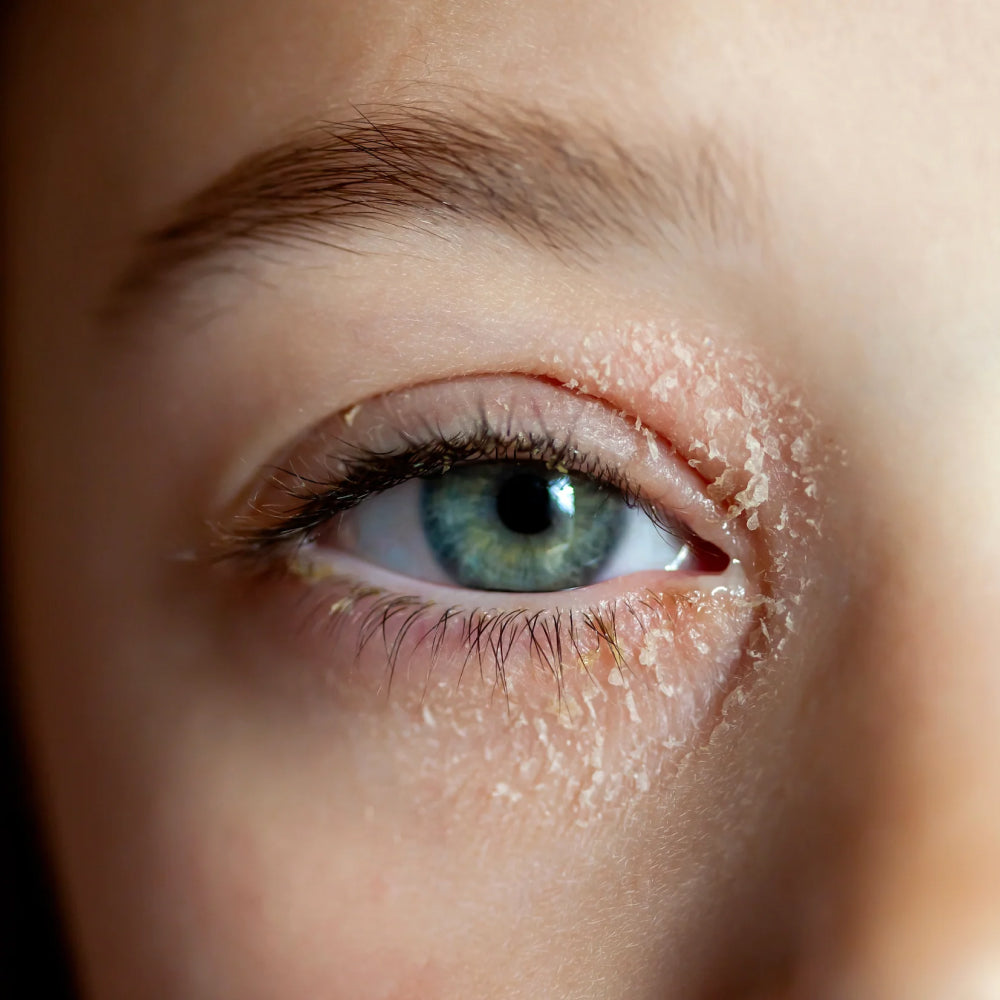Eye eczema can be frustrating and even painful, often causing discomfort such as irritation and redness. The dermatological condition usually manifests as dry or itchy skin on the eyelids. Genetic predisposition, allergies, cosmetics, and moisturizing creams are some contributing causes. Different types of eye eczema may require distinct approaches, but all aim to alleviate irritation effectively.
It is possible to reduce symptoms with both prescription medications and home cures.
In this article, we'll discover the main types of this skin condition, its underlying causes, and how to treat eczema around the eye.
What Does Eczema Around the Eye Look Like?
The region around the eyes might develop multiple forms of eczema stimulated by surrounding allergens or irritants and may cause eyelid redness, irritation, and puffiness.
Seborrheic dermatitis primarily affects the eyelid margins, causing pigmentation and redness. Some people may be genetically predisposed to react more readily to outside stimuli. Studies suggest a notable proportion of people with atopic dermatitis are more likely to develop conditions related to the inflamed sensitive membranes lining the eyelid (Chaudhary & Agrawal, 2024, Ethnic and Racial Disparities in Clinical Manifestations of Atopic Dermatitis).
Types of Eczema on the Eyelids and Around the Eye
To find the best treatment, being aware of the main types of eczema types related to the eye area is helpful.
-
Atopic Dermatitis
Atopic dermatitis often causes skin infections in adults and is frequently linked to asthma or hay fever. The primary root causes usually consist of genetic predispositions and external factors. Red, irritated, and puffy eyelids are possible signs, often caused by touching things that trigger allergies or irritation.
Studies indicate that people suffering from atopic dermatitis are more likely to result in the risk for conditions such as keratoconus due to persistent rubbing (National Eczema Association, 2022, Eczema and Your Eyes).
-
Contact Dermatitis
Affected by allergens or irritants, this type causes red, painful eyelids that can sting or burn. It may affect the upper or lower eyelids and cause thickening if it lasts long.
-
Seborrheic Dermatitis
Studies indicate that this skin condition is more prevalent among adults. It typically manifests on the facial regions, auricles, and scalp as a dense, oily, and scaly eruption. While it’s more likely for eye susceptibility to bacterial infections, severe complications are rare (National Center for Biotechnology Information, 2020, Seborrheic Dermatitis: Overview).
Causes and Symptoms of Eczema Around the Eye
Eczema is a skin disease that stimulates the immune system and causes redness and swelling. This happens because of your gene predisposition to changes in the environment.
Some common eczema triggers include:
-
Skin-related factors: Dry skin and irritants such as harsh soaps and detergents, and other skincare products that can strip moisture from the skin.
-
Environmental influences: Cold, dry weather and allergens from fabrics, plants, and pets
-
Health and stress: Emotional stress, excessive sweating, and infections from bacteria or viruses
-
Dietary factors: Food allergens like dairy, wheat, and nuts
How To Treat Eczema Around the Eye
Knowing how to treat eczema around the eye is essential to reduce discomfort and improve skin health. The main goals are calming the affected areas and preventing further irritation.
Specifically, consistent application of lotions, creams, and a special skincare regimen can lessen the occurrence of atopic dermatitis flare-ups. Identifying and avoiding triggers, such as particular clothes or cosmetic items, is crucial for managing contact dermatitis. In terms of seborrheic dermatitis, both prescription creams and over-the-counter shampoos work well to relieve dryness and irritation.
Home Remedies
Here are some effective options to consider that could bring you relief.
-
Avoiding Irritants: Avoid dust, pollen, harsh soaps, makeup, sweat, and laundry detergent. Always clean your hands before touching your eyes.
-
Cold Compress: This can lessen swelling, itching, and skin discoloration in irritated regions.
-
Petroleum Jelly: Certain products that help keep skin moist, like Vaseline and Aquaphor, can also reduce swelling. You should ask your doctor which one would work best for you.
-
Bath Routine: Take a quick bath or shower (5-10 minutes) using warm water. A bleach bath once or twice a week helps to eradicate bacteria.
-
Moisturizers: Apply a thick, unscented moisturizer at least after a shower while your skin is still damp. Don’t forget to verify if the product is safe for delicate regions like the area around the eyes.
-
Humidifiers: A humidifier will assist your skin in keeping the air hydrated in arid settings.
-
Gentle Cleaning: Wash your face with a gentle, unscented cleanser when the affected area flares up.
-
Nail Care: Did you know that long nails can make eczema worse? Maintaining short fingernails helps avoid scratching and minimize any damage to the skin around your eyes.
Keep in mind that your doctor must be consulted before starting any new type of treatment.
Over-the-Counter (OTC) Treatment
Non-steroidal treatments are gentle on the skin and effective for managing symptoms in sensitive areas. Phoilex’s botanically derived products can calm inflamed skin, relieve itchiness and scaling, strengthen the skin barrier for increased resilience, lessen the chances of flare-ups, and provide enduring moisture for a vibrant, healthy complexion.
-
Active ReLeaf Spot Gel quickly hits irritation on the skin, soothing and moisturizing it through its pharmacist-derived Phyto-Active Blend™.
-
Liverty Dynamic Drops promotes optimal liver and organ function, which helps strengthen your skin from the inside.
On the other hand, over-the-counter medicines like corticosteroid creams can help reduce itching. However, before using these items on delicate regions like the eyes, it is imperative to speak with a doctor.
Prescription Treatment
For people with moderate to severe eczema, a prescription medication may be required. The following are some typical medication choices that your physician may suggest:
-
Oral corticosteroids: Provide systemic relief
-
Topical calcineurin inhibitors: Non-steroid options helping manage eczema flare-ups without the risks associated with steroids
-
Prednisone: Oral medication for short-term management of severe symptoms
-
Ultraviolet light therapy: Reduce inflammation
Always consult your doctor for guidance tailored to your condition.
Phoilex for Irritated Skin
If you're looking for solutions on how to treat eczema around the eye, choosing products that promote healing and reduce internal inflammation is essential. Avoiding harsh ingredients that might make the skin more sensitive is important. Safe, effective products designed for delicate skin can make a significant difference.
Phoilex offers solutions tailored to your needs targeting internal inflammation for overall skin health. Our products are formulated to be gentle yet effective, ensuring you can find comfort and healing.
Explore these options for a safe and effective way to manage eczema around the eye and restore comfort to your skin.
FAQs:
Q: What are the most common symptoms of eczema around the eyes?
A: Eye eczema typically presents as red, itchy, and puffy eyelids, often accompanied by dry, flaky skin. The condition can affect both upper and lower eyelids, causing irritation, burning sensations, and in some cases, increased sensitivity to light and environmental factors.
Q: Can eye makeup cause or worsen eyelid eczema?
A: Yes, cosmetic products can trigger contact dermatitis, a type of eczema that develops when the skin reacts to irritants or allergens. Eye makeup, especially products containing fragrances or preservatives, can cause flare-ups in sensitive individuals and should be avoided during active episodes.
Q: How can I tell the difference between atopic dermatitis and contact dermatitis around my eyes?
A: Atopic dermatitis is typically chronic and often occurs alongside other allergic conditions like asthma or hay fever, while contact dermatitis appears after exposure to specific triggers and usually clears up when the irritant is removed. Contact dermatitis tends to cause more immediate burning or stinging, whereas atopic dermatitis is characterized by persistent itching and inflammation.
Q: Is it safe to use moisturizers around the eye area when experiencing eczema?
A: Gentle, fragrance-free moisturizers specifically formulated for sensitive skin can help manage eye eczema symptoms. However, it's important to choose products that are ophthalmologist-tested and designed for use around the eyes to avoid further irritation or complications.
Q: Can genetic factors increase my risk of developing eye eczema?
A: Yes, genetic predisposition plays a significant role in developing eye eczema, particularly in cases of atopic dermatitis. People with a family history of allergic conditions are more likely to experience eye eczema and may react more strongly to environmental triggers.
Q: What should I avoid when experiencing an eye eczema flare-up?
A: During flare-ups, avoid rubbing or scratching the affected area, as this can lead to skin infections and potentially serious eye complications like keratoconus. Additionally, stay away from harsh skincare products, fragranced items, and known allergens that could worsen the condition.
References:
-
National Center for Biotechnology Information, Pike USNL of M 8600 R, MD B, USA 20894. Seborrheic Dermatitis: Overview. Institute for Quality and Efficiency in Health Care (IQWiG); 2020. https://www.ncbi.nlm.nih.gov/books/NBK532846/
-
National Eczema Association. (2024). What is contact dermatitis and how is it treated? National Eczema Association. https://nationaleczema.org/eczema/types-of-eczema/contact-dermatitis/
-
National Eczema Association. (2022, September 2). Eczema and Your Eyes. National Eczema Association. https://nationaleczema.org/blog/the-eye-condition-that-people-with-eczema-need-to-know-about/
-
Chaudhary, F., & Agrawal, D. K. (2024). Ethnic and Racial Disparities in Clinical Manifestations of Atopic Dermatitis. Archives of Internal Medicine Research, 07(02). https://doi.org/10.26502/aimr.0170
Read more

Eczema symptoms often worsen as temperatures rise with the arrival of spring. Seasonal changes may have a huge influence on skin health, so it's critical to know what causes these flare-ups this ti...

Dealing with skin conditions like eczema or athlete’s foot can be frustrating, as the irritation often prevents you from enjoying your favorite activities. Although both conditions share symptoms l...
